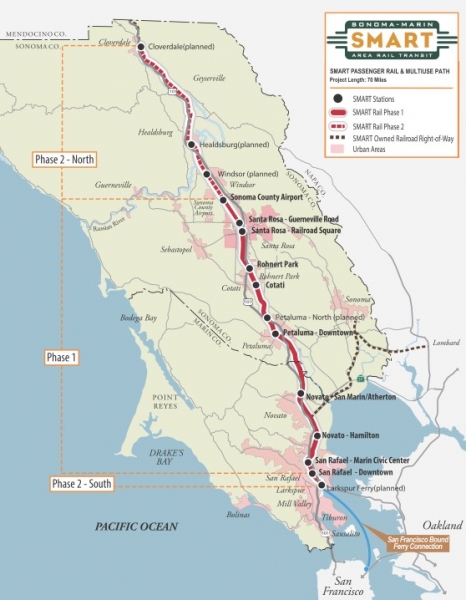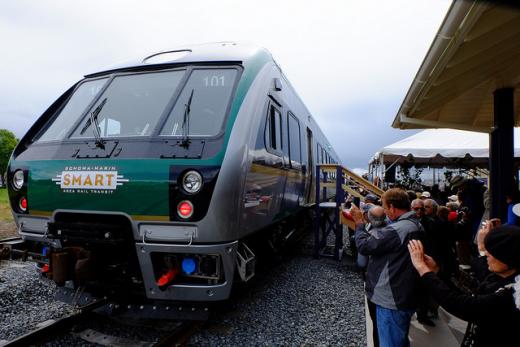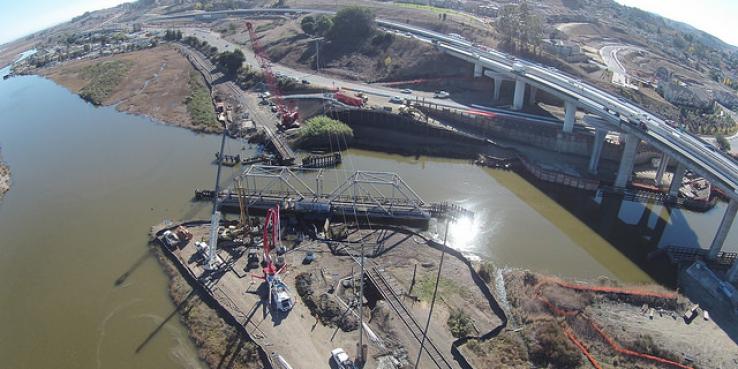Many communities in Marin and Sonoma County grew up around rail. At its peak in the 1920s, North Bay passenger rail ridership was among the busiest in California. The remnants of this legacy are the walkable downtowns adjacent to former rail stations in many North Bay cities — even though passenger rail service connecting Sonoma and Marin Counties has been absent for almost 60 years. Now, after decades of hard work by locals, passenger trains will once again connect the North Bay's communities by rail: Sonoma Marin Area Rail Transit (SMART) will begin passenger rail service in December 2016.
SMART will begin service on a 43-mile long segment from San Rafael to the Sonoma County Airport, making stops in Novato, Petaluma, Cotati, Rohnert Park and Santa Rosa. Two-car trains will carry up to 318 passengers (158 seated, 160 standing) along with 24 bicycles. In the future, SMART would extend to the very north of Sonoma County at Cloverdale, and south to the ferry terminal at Larkspur Landing. The original project was supposed to be 70 miles but is being phased due to higher costs than projected and less funding than expected.
SMART Passenger Rail Route
 Source: Sonoma Marin Rail Transit
Source: Sonoma Marin Rail Transit
Passenger trains operated by Northwestern Pacific once served the North Bay, providing service as far north as Eureka. At Sausalito and Tiburon, passengers made seamless transfers to ferries bound for San Francisco and other parts of the bay. Regular service within Marin and Sonoma counties ended in 1958. However, support for rail service persisted. Marin residents were interested in BART but were forced to leave the project in May 1962, after project costs unexpectedly increased when San Mateo County left the BART district.
In 2008, Marin and Sonoma county residents voted in favor of a quarter-cent sales tax to pay for SMART. Since then, SMART has been replacing old track and bridges, rehabilitating historic tunnels, installing crossing gates and station platforms, testing trains and a host of other tasks necessary to establish a passenger rail service.
 An April 2014 ceremony at the Cotati SMART Station celebrated the arrival of SMART's first train car set. Courtesy SMART.
An April 2014 ceremony at the Cotati SMART Station celebrated the arrival of SMART's first train car set. Courtesy SMART.
During the decades without rail service, most of the North Bay’s growth has been auto-oriented and situated along and near Highway 101. Unfortunately, traffic congestion is growing and is only going to get worse (66 percent of Marin county and 76 percent of Sonoma county residents commute alone by car). Congestion in Marin is expected to grow at three times the rate of population growth in the next 20 years. Some road expansion projects are moving forward, but they will not solve congestion in the long run. SMART rail is an investment in, and a bet on, growing differently.
The first 43-mile phase of SMART will cost $427.9 million. That includes the trains, operations and maintenance facilities, as well as 10 stations and translates roughly to $10 million per mile. In comparison, the nearby Wilfred Avenue interchange project in Rohnert Park cost $40 million to add just 1.6 miles of high-occupancy vehicle lanes, wider on/off ramps and a new overpass/underpass. Although highway improvements are needed, the comparison illustrates SMART’s potential to move people in a cost effective manner.
SMART’s level of service will be modest when compared to more urban rail services in the Bay Area – a train every 30 minutes during peak hours, and limited off-peak service. However, as Caltrain has shown, by adding more trains and running express services (like Caltrain’s Baby Bullet), it is possible to scale up when demand increases. Funding has been secured by SMART to connect to the Larkspur Ferry and will provide a ferry connection to San Francisco.
SMART will join the more than two dozen transit agencies already operating in the Bay Area, and will have to work cooperatively with the transit agencies already operating in Marin and Sonoma Counties (Golden Gate Ferry, Golden Gate Transit, Marin Transit, Sonoma County Transit, Amtrak bus, Santa Rosa CityBus, Petaluma Transit) to provide a seamless travel experience across multiple systems.
As the opening date approaches, we can explore the big planning questions. How will new passenger rail service shape growth? Will it help communities to locate jobs, retail and housing near stations and, in doing so, preserve open space? Because 75 percent of trips in Sonoma and Marin counties are made within the region, focusing growth within walking distance of SMART stations makes sense. North Bay downtowns are popular tourist destinations, and new development would strengthen their appeal. SMART would in turn provide the means for visitors to reach their destinations without adding to congested highways. Job sites further from stations could operate shuttles to ferry their employees to SMART.
The North Bay is fortunate to have both a network of historical rail infrastructure and passionate local initiative devoted to reviving passenger rail. As we have learned from other parts of the region, SMART’s inaugural operation in late 2016 will be a milestone, but much work will continue to be needed to ensure its success. As such, while the potential benefits of returned passenger rail service to the North Bay are great, they are ultimately contingent on the willingness of North Bay communities to embrace SMART.
ABOUT THE AUTHOR
Zack Dinh is an urban designer and transportation planner working in Oakland.
